Pyplan is a no‑code / low‑code platform designed so that we can perform many data manipulation and processing tasks without writing code.
One of Pyplan’s main goals is to make the calculation logic transparent. We can:
- Navigate the influence diagram to understand the flow of calculations.
- Select individual steps (nodes), execute them, and see their results.
Each node’s result can be displayed either as a table or as a chart, depending on the data type and the selected view.
When we browse the influence diagram, we can select any node, run it, and inspect its output independently.

¶ Display in Table format
By clicking on the green node with the title “Data” we will see the following:

¶ Run the node
To run the node, we click the evaluation (Play) icon in the result area or in the node toolbar. After the node finishes executing, Pyplan displays the result as a table.
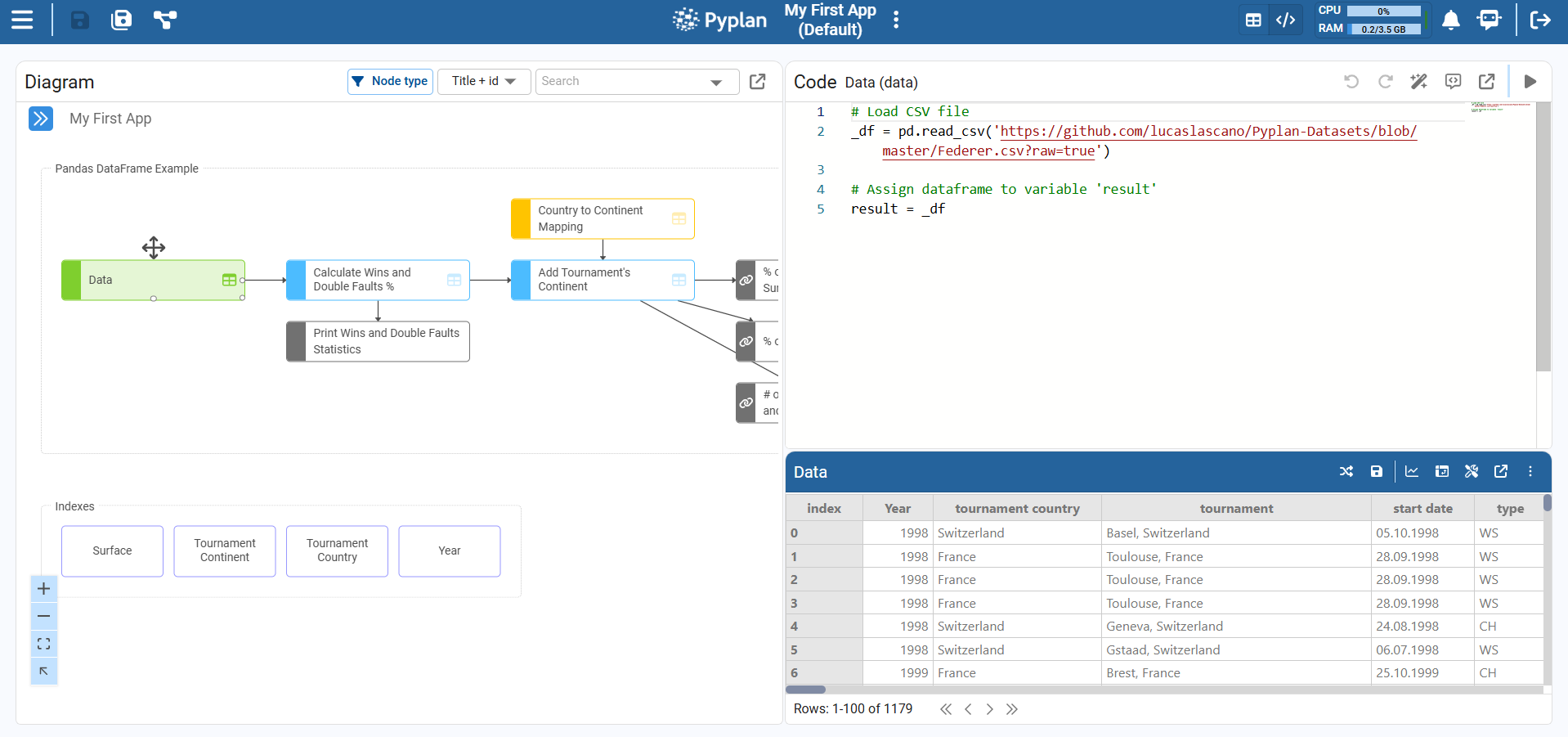
¶ Maximizing the display window
When we want to work more comfortably with a large table, we can maximize the result widget so that it occupies almost the entire interface.
In the table header (the blue bar that shows the node title, for example “Data”), on the top‑right corner of the widget, we find the maximize icon. In the screenshot, this is the square/expand icon located just to the left of the close button.
- Clicking this icon switches the table to maximized mode, as shown in the image: the table stretches to use all the available width and height of the central area, making it easier to scroll, compare columns, and review many rows at once.
- When the table is maximized, the icon changes to Minimize, and a tooltip with the text “Minimize” is shown when we hover over it.
- Clicking Minimize returns the widget to its original size and position inside the interface layout, so we can continue working with other components or nodes.
This maximize / minimize behavior lets us quickly switch between a detailed, full‑screen inspection of the data and the normal, multi‑component layout of the interface.
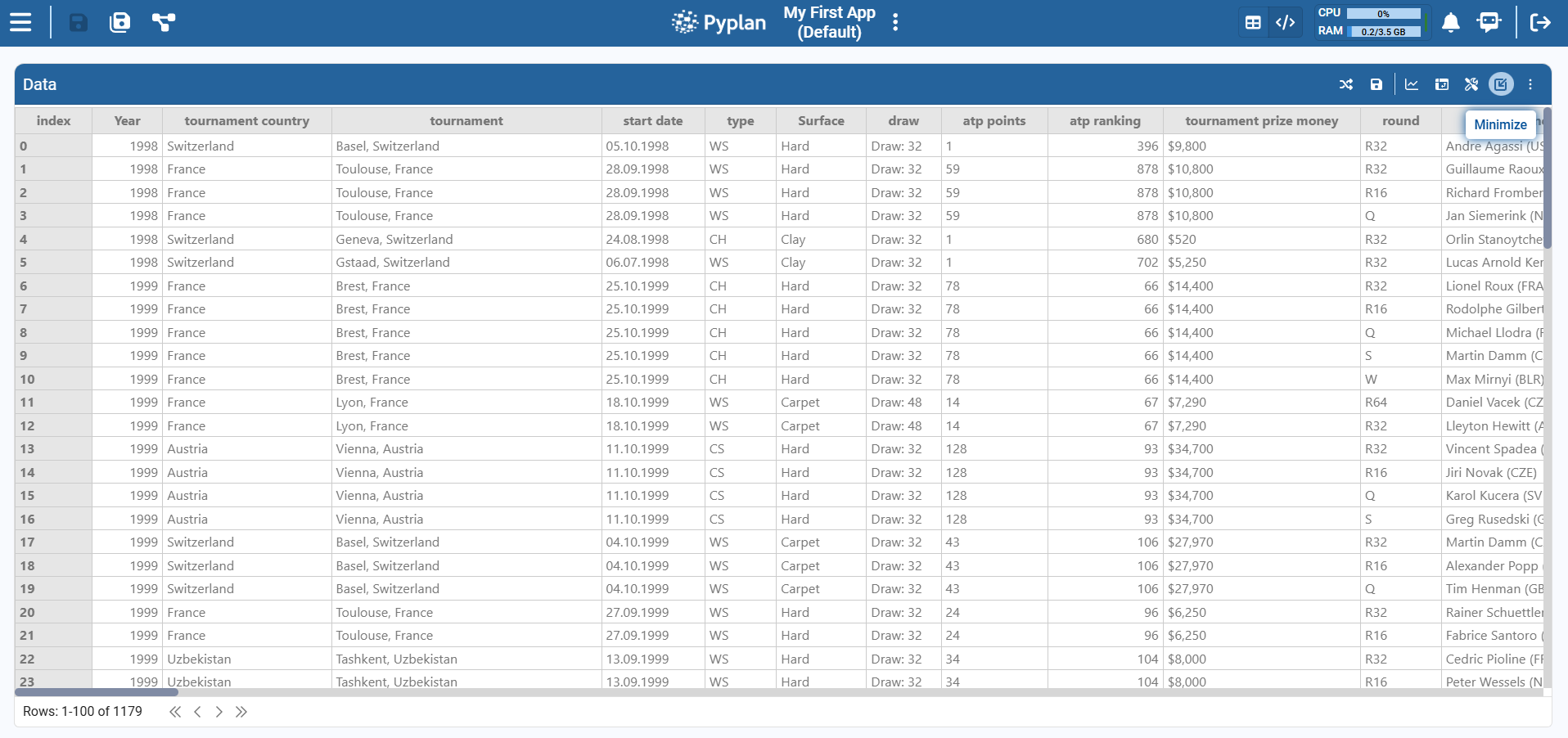
¶ Data handling
Once the node result is displayed as a table, we can start shaping the data directly from the pivot‑style view shown in the images.

To access this pivot-style view, we first need to click the table configuration icon in the top‑right corner of the result widget. Once this view is active, the left panel shows the Fields list:
- Each row corresponds to a column of the underlying DataFrame.
- The icon indicates the type (
#for numeric,Tfor text). - For numeric fields we also see the default aggregation (Sum, Avg, Min, Max, Count).
- On the right of each field we have a small filter icon, which we will use later for advanced filtering.

On the top of the table, we see three areas:
- Rows
- Columns
- Measures
This works like a pivot table:
- We drag dimensions (categorical fields) from the Fields list to Rows or Columns.
- Example from the first image:
Yearandtournament countryare in Rows, andSurfaceis in Columns.
- Example from the first image:
- We drag measures (numeric fields) to Measures.
- In the example,
winneris dragged to Measures, so the table shows the count of wins for each combination of Year, Country, and Surface.
- In the example,
Pyplan automatically rebuilds the table according to this configuration, aggregating the selected measure(s) using the chosen function (Sum, Average, etc.) over the remaining dimensions.
¶ Table Format
When we click the Settings icon in a table widget, Pyplan opens the table configuration panel. This panel is organized into several sections:
- General
- Data
- Styles
- Index sync
- Scenarios
The General and Data sections contain standard options (such as titles, paging, and data‑related settings) that users can explore on their own. In this section we focus on Styles, which control how the table looks and how values are highlighted.

¶ Styles
Within the Styles section we control the visual appearance of the table cells.
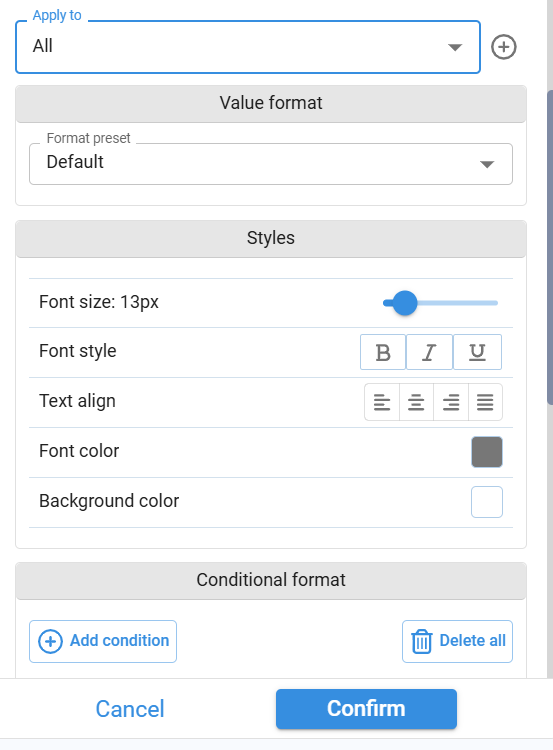
Apply to
At the top we choose the scope of the style.
- By default it is set to All, so the configuration applies to the entire table.
- We can change it to apply styles only to a specific field, measure, or area and add new targets with the “+” button.
Value format
- Format preset lets us choose how values are displayed (for example, Default, Number, Percentage, Currency).
- This affects the numeric representation but not the underlying data.
Styles
- Font size: slider to define the text size (e.g. 13px in the screenshot).
- Font style: buttons for Bold (B), Italic (I) and
(U) to emphasize values.
- Text align: alignment of the text inside each cell (left, center, right, justified).
- Font color: color picker to change the text color.
- Background color: color picker to define the cell background.
These options allow us to quickly adapt the table style to match the interface design or to highlight specific areas of the data.
¶ Conditional format
The Conditional format section lets us apply styles based on value‑based rules.
To define a conditional format, we:
- Add one or more conditions (for example, “atp ranking < 50”).
- Choose the style to apply when the condition is met (font color, background color, bold, etc.).
- Optionally add multiple rules for different value ranges.
This allows us to highlight outliers, good/bad results, thresholds, or alerts directly in the table.
¶ Heatmap
The Heatmap option applies a color gradient to numeric values so that higher and lower values can be visually distinguished at a glance.
Once enabled, Pyplan automatically assigns colors based on the value range of the selected measure(s).
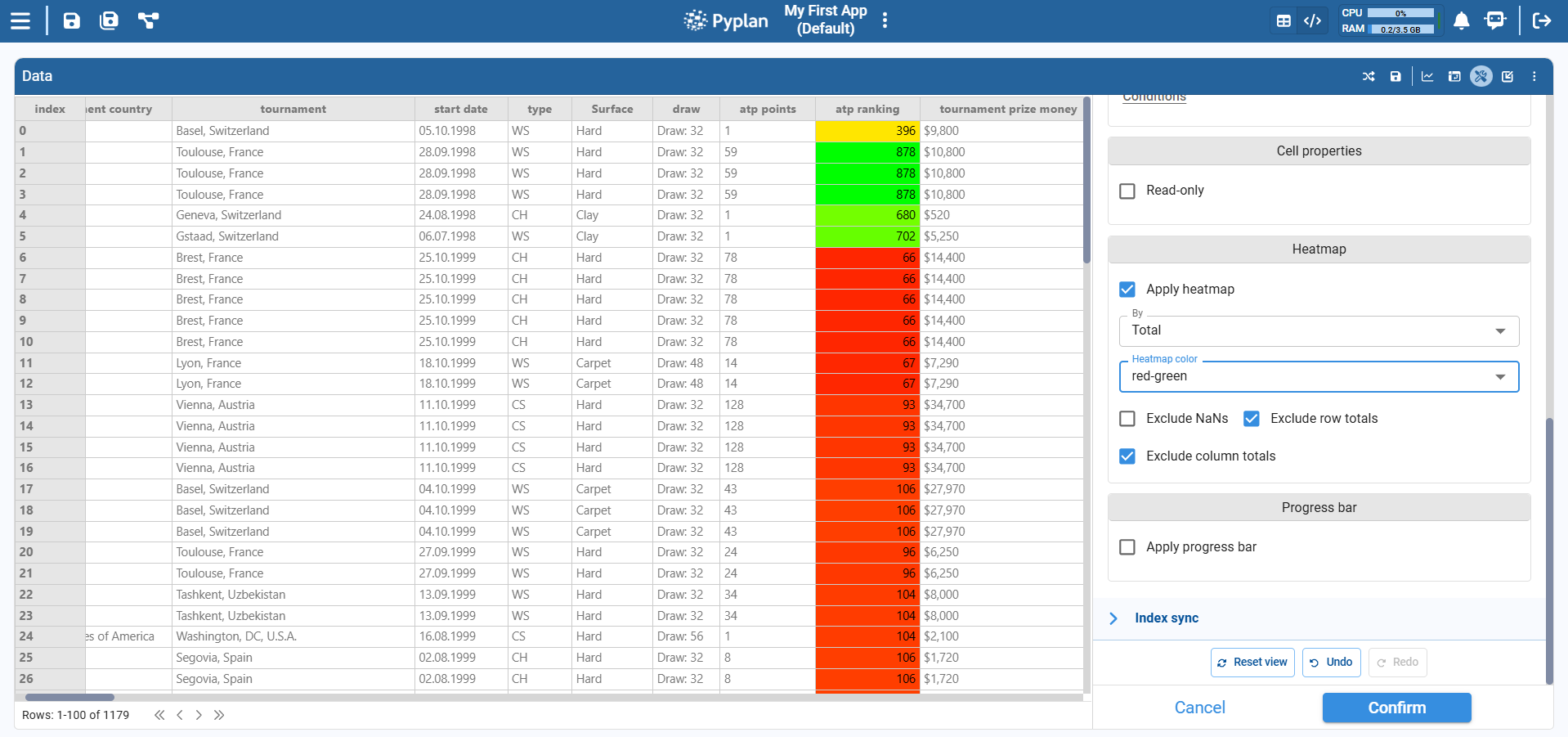
¶ Progress Bar
The Progress bar format displays numeric values as horizontal bars inside each cell, making it easy to compare magnitudes visually.
We can then adjust the value range and colors if options are available, so the bar reflects the percentage or relative value we want to show.
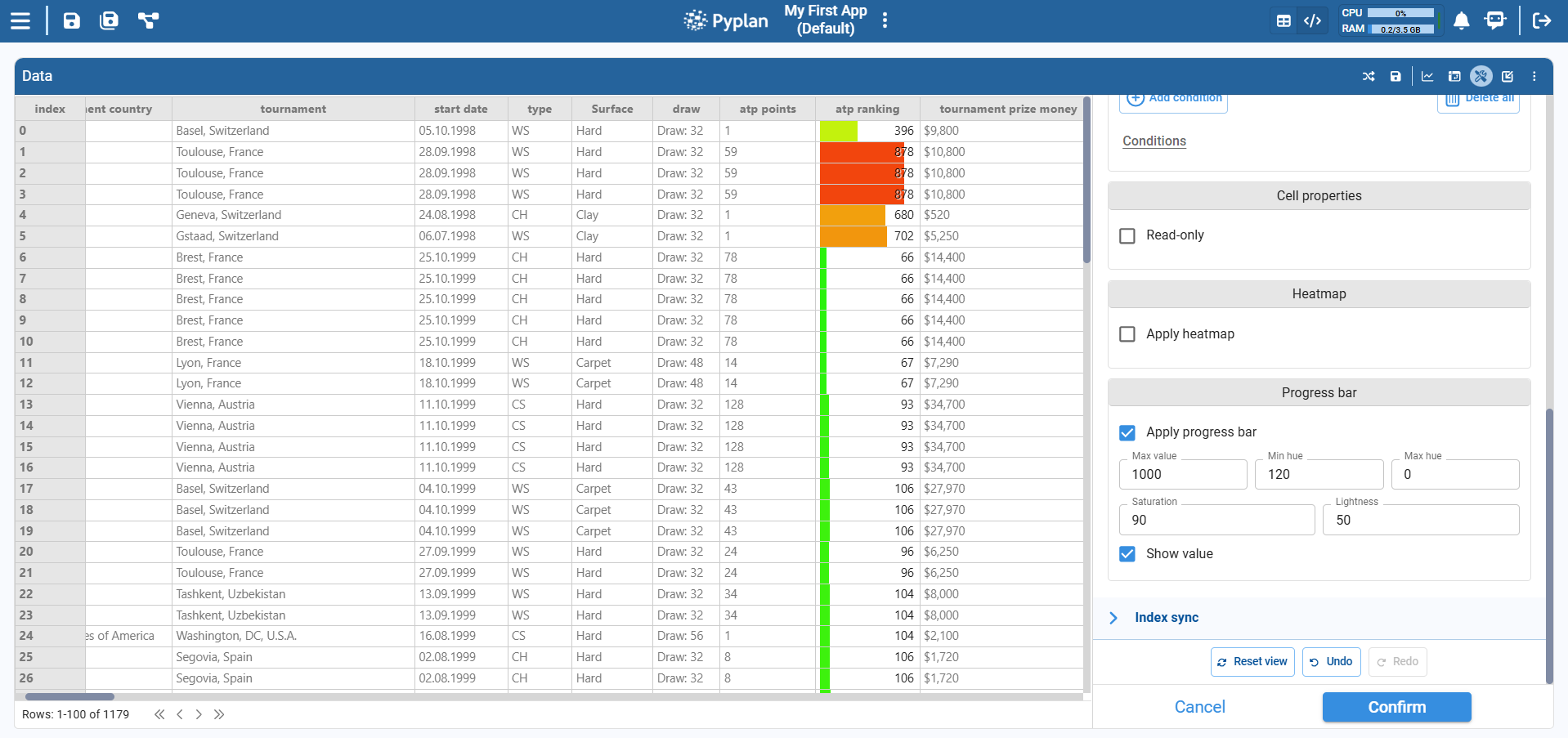
¶ Visualization in Graph format
Clicking on the graph section switches the view from table to chart. Whenever the selected chart type allows it, Pyplan automatically assigns fields from the table to the chart.
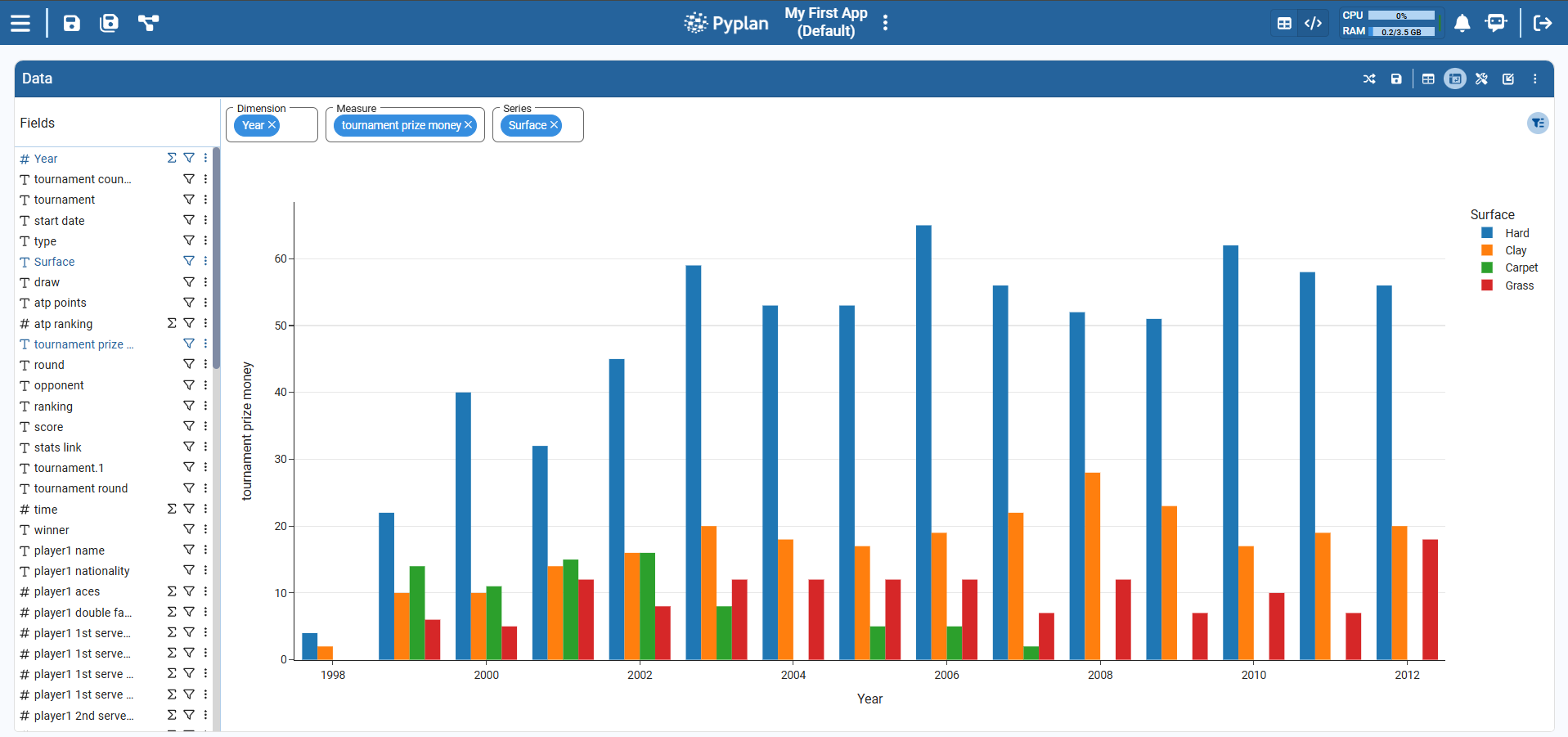
¶ Visualization Configuration
In Pyplan we can choose from multiple chart types to visualize our data. Each chart type (bar, line, area, scatter, etc.) has its own sub‑types and specific options.
When we select a chart type in the interface, Pyplan automatically shows the set of properties that are required to build that chart (for example: x‑axis, y‑axis, color, facet, aggregation, etc.). By filling in these fields we can configure most common visualizations without writing code.

¶ Coding Visualizations
Through the interface we can configure the most frequently used parameters of each chart. However, many additional properties are available when we edit the component code.
To customize a visualization via code:
- In the chart widget, click the component menu icon (top‑right of the chart).
- Select Show component code.
- In the code panel that appears, switch Code from Default to Custom.
Once the switch is set to Custom, we can edit the Python code that defines the Plotly Express chart and:
- Add or modify layout options (titles, legends, margins, annotations).
- Adjust colors, scales, templates, and interactions beyond what is exposed in the UI.
- Implement advanced Plotly features that are not available in the visual configuration.
A complete guide to the configurable properties of each plot can be found here: Plotly Express Documentation